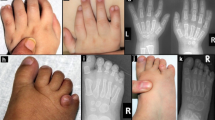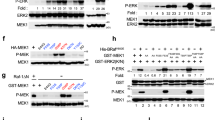Abstract
Cardio-facio-cutaneous syndrome (CFCS) is a rare disease characterized by mental retardation, facial dysmorphisms, ectodermal abnormalities, heart defects and developmental delay. CFCS is genetically heterogeneous and mutations in the KRAS, BRAF, MAP2K1 (MEK1) and MAP2K2 (MEK2) genes, encoding for components of the RAS–mitogen activated protein kinase (MAPK) signaling pathway, have been identified in up to 90% of cases. Here we screened a cohort of 33 individuals with CFCS for MEK1 and MEK2 gene mutations to further explore their molecular spectrum in this disorder, and to analyze genotype–phenotype correlations. Three MEK1 and two MEK2 mutations were detected in six patients. Two missense MEK1 (L42F and Y130H) changes and one in-frame MEK2 (K63_E66del) deletion had not been reported earlier. All mutations were localized within exon 2 or 3. Together with the available records, the present data document that MEK1 mutations are relatively more frequent than those in MEK2, with exons 2 and 3 being mutational hot spots in both genes. Mutational analysis of the affected MEK1 and MEK2 exons did not reveal occurrence of mutations among 75 patients with Noonan syndrome, confirming the low prevalence of MEK gene defects in this disorder. Clinical review of known individuals with MEK1/MEK2 mutations suggests that these patients show dysmorphic features, ectodermal abnormalities and cognitive deficit similar to what was observed in BRAF-mutated patients and in the general CFCS population. Conversely, congenital heart defects, particularly mitral valve and septal defects, and ocular anomalies seem to be less frequent among MEK1/MEK2 mutation-positive patients.
Similar content being viewed by others
Log in or create a free account to read this content
Gain free access to this article, as well as selected content from this journal and more on nature.com
or
References
Roberts A, Allanson J, Jadico SK et al: The cardiofaciocutaneous syndrome. J Med Genet 2006; 43: 833–842.
Niihori T, Aoki Y, Narumi Y et al: Germline KRAS and BRAF mutations in cardio-facio-cutaneous syndrome. Nat Genet 2006; 38: 294–296.
Narumi Y, Aoki Y, Niihori T et al: Molecular and clinical characterization of cardio-facio-cutaneous (CFCS) syndrome: overlapping clinical manifestations with Costello syndrome. Am J Med Genet A 2007; 143: 799–807.
Rodriguez-Viciana P, Tetsu O, Tidyman WE et al: Germiline mutations in genes within the MAPK pathway cause cardio-facio-cutaneous syndrome. Science 2006; 311: 287–290.
Schubbert S, Zenker M, Rowe SL et al: Germline KRAS mutations cause Noonan syndrome. Nat Genet 2006; 38: 331–336.
Schubbert S, Shannon K, Bollag G : Hyperactive Ras in developmental disorders and cancer. Nat Rev Cancer 2007; 7: 295–308.
Tartaglia M, Mehler EL, Goldberg R et al: Mutations in PTPN11, encoding the protein tyrosine phosphatase SHP-2, cause Noonan syndrome. Nat Genet 2001; 29: 465–468.
Tartaglia M, Pennacchio LA, Zhao C et al: Gain-of-function SOS1 mutations cause a distinctive form of Noonan syndrome. Nat Genet 2007; 39: 75–79.
Carta C, Pantaleoni F, Bocchinfuso G et al: Germline missense mutations affecting KRAS isoform B are associated with a severe Noonan syndrome phenotype. Am J Med Genet 2006; 79: 129–135.
Pandit B, Sarkozy A, Pennacchio LA et al: Gain of function RAF1 mutations cause Noonan and Leopard syndromes with hypertrophic cardiomyopathy. Nat Genet 2007; 39: 1007–1012.
Razzaque MA, Nishizawa T, Komoike Y et al: Germline gain-of-function mutations in RAF1 cause Noonan syndrome. Nat Genet 2007; 39: 1013–1017.
Roberts A, Araki T, Swanson KD et al: Germline gain-of-function mutations in SOS1 cause Noonan syndrome. Nat Genet 2007; 1: 70–74.
Digilio MC, Conti E, Sarkozy A et al: Grouping of multiple-lentigines/LEOPARD and Noonan syndromes on the PTPN11 gene. Am J Hum Genet 2002; 71: 389–394.
Aoki Y, Niihori T, Kawame H et al: Germline mutations in HRAS proto-oncogene cause Costello syndrome. Nat Genet 2005; 37: 1038–1040.
Bentires-Alj M, Kontaridis MI, Neel BG : Stops along the RAS pathway in human genetic disease. Nat Med 2006; 12: 283–285.
Nava C, Hanna N, Michot C et al: Cardio-facio-cutaneous and Noonan syndromes due to mutations in the RAS/MAPK signalling pathway: genotype-phenotype relationships and overlap with Costello syndrome. J Med Genet 2007; 44: 763–771.
Schulz AL, Albrecht B, Arici C et al: Mutation and phenotypic spectrum in patients with cardio-facio-cutaneous and Costello syndrome. Clin Genet 2008; 73: 62–70.
Nyström AM, Ekvall S, Berglund E et al: Noonan and cardio-facio-cutaneous syndromes: two clinically and genetically overlapping disorders. J Med Genet 2008; 45: 500–506.
Shaul YD, Seger R : The MEK/ERK cascade: from signaling specificity to diverse functions. Biochim Biophys Acta 2007; 1773: 1213–1226.
Yoon G, Rosenberg J, Blaser S, Rauen KA : Neurological complications of cardio-facio-cutaneous syndrome. Dev Med Child Neurol 2007; 49: 894–899.
Gripp KW, Lin AE, Nicholson L et al: Further delineation of the phenotype resulting from BRAF or MEK1 germline mutations helps differentiate cardio-facio-cutaneous syndrome from Costello syndrome. Am J Med Genet A 2007; 143: 1472–1480.
Armour CM, Allanson JE : Further delineation of cardio-facio-cutaneous syndrome: clinical features of 38 individuals with proven mutations. J Med Genet 2008; 45: 249–254.
Kavamura MI, Peres CA, Alchorne MM, Brunoni D : CFC index for the diagnosis of cardiofaciocutaneous syndrome. Am J Med Genet 2002; 112: 12–16.
Marino B, Digilio MC, Toscano A, Giannotti A, Dallapiccola B : Congenital heart diseases in children with Noonan syndrome: an expanded cardiac spectrum with high prevalence of atrioventricular canal. J Pediatr 1999; 135: 703–706.
Al-Rahawan MM, Chute DJ, Sol-Church K et al: Hepatoblastoma and heart transplantation in a patient with cardio-facio-cutaneous syndrome. Am J Med Genet A 2007; 143: 1481–1488.
Van Den Berg H, Hennekam RC : Acute lymphoblastic leukaemia in a patient with cardiofaciocutaneous syndrome. J Med Genet 1999; 36: 799–800.
Makita Y, Narumi Y, Yoshida M et al: Leukemia in cardio-facio-cutaneous (CFC) syndrome: a patient with a germline mutation in BRAF proto-oncogene. J Pediatr Hematol Oncol 2007; 29: 287–290.
Acknowledgements
We thank the patients and families who participated in this study and the physicians who referred the individuals. This study was supported by grants from the Italian Ministry of Health, Ricerca Corrente 2008 (BD and FL), Telethon-Italy grant GGP07115 (MT), FIRB 2006 (BD), and ‘Programma di Collaborazione Italia-USA/malattie rare’ (AS and MT). VC was supported by a fellowship from Associazione ONLUS ‘Morgan Di Gianvittorio per la cura e la ricerca nei tumori e leucemie in età pediatrica’.
Author information
Authors and Affiliations
Corresponding author
Rights and permissions
About this article
Cite this article
Dentici, M., Sarkozy, A., Pantaleoni, F. et al. Spectrum of MEK1 and MEK2 gene mutations in cardio-facio-cutaneous syndrome and genotype–phenotype correlations. Eur J Hum Genet 17, 733–740 (2009). https://doi.org/10.1038/ejhg.2008.256
Received:
Revised:
Accepted:
Published:
Issue date:
DOI: https://doi.org/10.1038/ejhg.2008.256
Keywords
This article is cited by
-
Intrinsically active MEK variants are differentially regulated by proteinases and phosphatases
Scientific Reports (2018)
-
Atrial ERK1/2 activation in the embryo leads to incomplete Septal closure: a novel mouse model of atrial Septal defect
Journal of Biomedical Science (2017)
-
Diagnosis of Noonan syndrome and related disorders using target next generation sequencing
BMC Medical Genetics (2014)



